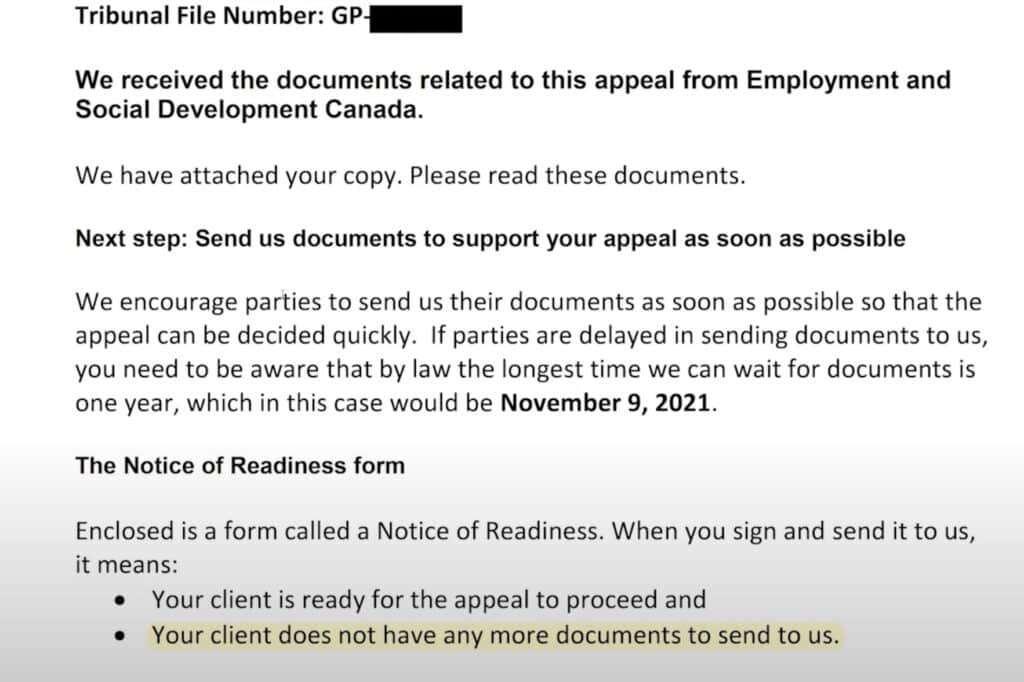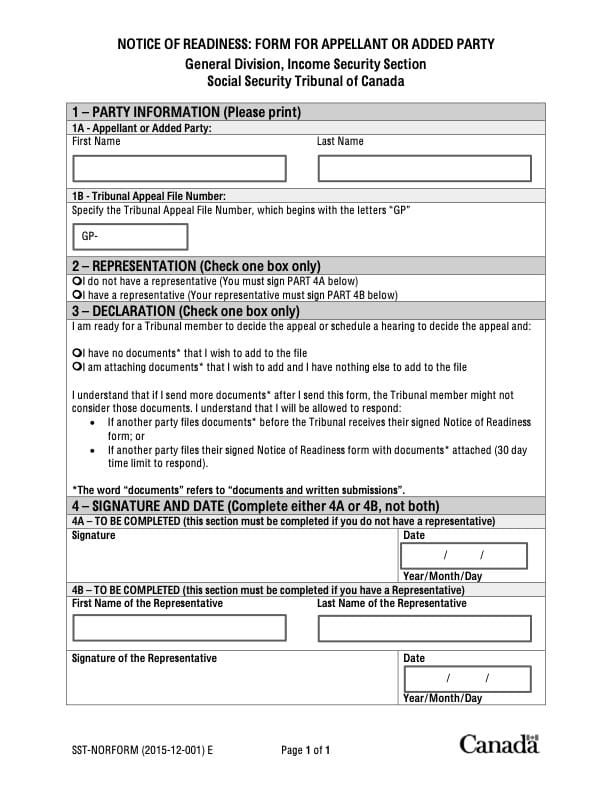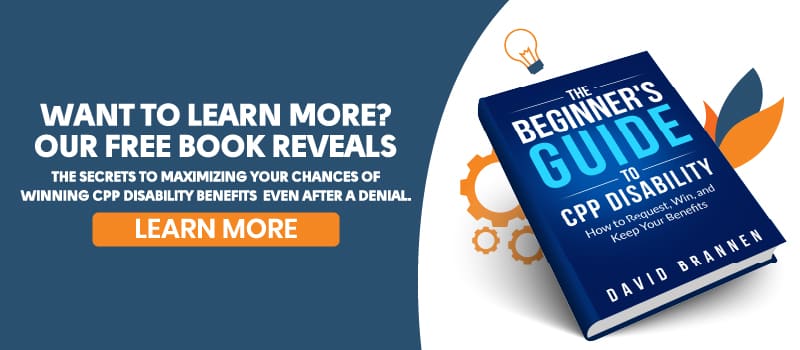If you are currently appealing your CPP disability benefits claim to the Social Security Tribunal, and have received the Notice of Readiness Form in the mail, then this may be the most important article you have ever read.
You are about to learn how you can avoid the single biggest mistake. This is a mistake that can almost guarantee you will lose your CPP disability case. I see people make this mistake over and over. It is a mistake so bad that it usually can’t be fixed, even by a lawyer.
So, what is this big mistake?
Filling out and sending in your Notice of Readiness Form to the Social Security Tribunal before you have submitted all the documents necessary to maximize your chances of winning.
This is a big issue now because the Social Security Tribunal started sending these forms out on December 31, 2015. They are sending them to people who have just filed their appeal with the Social Security Tribunal.
In this article, I explain why filling out and sending in your Notice of Readiness Form at the wrong time can almost guarantee you will lose your CPP Disability Appeal, even if you are honest and truly disabled from work.
I review the Notice of Readiness Form and discuss the mistakes you need to avoid. I also explain what you should do before you fill out and send in your Notice of Readiness Form.
Overview of the CPP Disability Appeal Process
It is important to understand how the CPP disability claim appeals process works, so you can better understand how the Notice of Appeal Form fits into the overall system.
You apply for CPP disability benefits by filing an application with Service Canada. If Service Canada denied your claim, then you must appeal to try and win your case. There are basically two levels of appeal. The first appeal is with Service Canada and is called a Reconsideration Appeal.
Service Canada Reconsideration Appeal
If Service Canada denies your initial application for CPP disability benefits, you have 90 days to ask them to reconsider. This is called a Reconsideration Appeal. You can send new documents and information (called submissions) to Service Canada. The Medical Adjudicator will consider these when doing the Reconsideration Appeal. The important thing about the Reconsideration appeal is that it’s still done within Service Canada by Service Canada employees.
Social Security Tribunal
If Service Canada denies your claim again at the Reconsideration level, then you have 90 days to appeal your case to the next level. The next level is the Social Security Tribunal or SST. The SST is a specialized court that makes final decisions on people’s rights to win CPP disability benefits. You appeal to the Social Security Tribunal by filing the required appeal documents and information.
Once you file a proper Notice of Appeal, you get a letter from the SST that explains the next steps. Among other things, this letter will also attach the Notice of Readiness Form. The letter looks like this:

The letter will say you have one year (365 days) to file documents. And will provide the date of that deadline. As you can see, the deadline in this example is November 9, 2021.
The letter will also tell you that you don’t have to wait the full year (not pictured above). And that at any time, either you or Service Canada can request an early Tribunal Hearing by filing the Notice of Readiness Form.
What is the Social Security Tribunal Notice of Readiness Form?
You will get a Notice of Readiness Form in the mail shortly after you file your Notice of Appeal documents with the Social Security Tribunal. It comes with the letter described above.
You can recognize this Notice of Readiness Form because it looks exactly like this:

This Form is important. Once you fill it out and send it back to the Social Security Tribunal, you are certifying that you have no more documents to provide in support of your case. You are confirming that you’re ready to schedule your Tribunal Hearing.
The Notice of Readiness Form is only one page and is very easy to fill out. In my opinion, that is part of the danger. It is easy not to realize how important this form is and what a mistake it is to send it in before your case is properly prepared.
The key part of the form is the Declaration Section. Here, it requires you to declare that “I have no document I wish to add to my file” or “I am attaching documents that I wish to add, and I have nothing else to add to the file.”
It is this part of the form that can cause all the problems for you
Now that we’ve covered the basics, let’s break down the fatal mistake I eluded to at the beginning of the article.
The Fatal Mistake Explained
I want to explain why I believe sending in the Notice of Readiness form without gathering all the necessary documents and evidence can be a big mistake. More importantly, I want to discuss why I think otherwise smart people make this fatal error.
In my experience, most people share the same misconception about what it takes to win a disability benefits claim. People believe that the key to winning a disability case is “actually being disabled.”
The thinking goes like this. “I know that I am disabled and am not faking it. My doctor supports me, so eventually, Service Canada or the Tribunal Judge will realize this too.” I want to emphasize that this line of thinking is dangerous and may cause you to lose your otherwise winnable case.
This may seem hard to believe, but the truth of your situation is not the most important factor in winning a disability claim. You may be honest and legitimately disabled, but you can’t win on that fact alone. This is because the Tribunal Judge won’t decide your case based on the truth of your situation as you know it. Rather, they will make a decision based on the documents, paperwork, and medical records that you submit with your appeal.
This is why lawyers often tell people the truth doesn’t matter; what matters is what you can prove in court. The lawyer and client may know something is true but can’t prove it in court for whatever reason. This same principle is at work against you.
If the documents you have submitted do not reveal the truth of your situation, then you will lose.
What actually wins disability claims? Evidence.
The key to winning is to provide documents and evidence that are convincing to the judge. In other words, you need to “prove” your claim using evidence that the judge will find convincing.
It really doesn’t matter what you think or what your doctor thinks is “proof” of your disability. The only question you should be asking is whether you have provided “proof” that will convince the Tribunal Judge. When it comes to winning or losing a disability claim, the judge’s opinion is the only one that matters.
This is what separates great lawyers from not-so-great lawyers. Great lawyers know how to present a case in a way that is convincing to the judge. Great lawyers will tell you that most cases are won or lost before you get to court. Many people think lawyers who are fancy talkers can win a case simply with fancy talk. This is not true at all. Cases are often won or lost depending on how well the case was prepared before the start of the trial or hearing.
It is important to appreciate that you can absolutely lose your case, even though you are “actually disabled.” This is the same thing as an innocent person being wrongfully convicted of a crime. It’s not the existence of the truth but whether you can prove that “truth” in court. This is why simply “being disabled” is not the most important part of winning a disability claim.
Now that my evidence rant is over let’s discuss how this connects to the Notice of Readiness form.
Once you file the Notice of Readiness, you may be stuck with it (even if you made a mistake)
When you file the Notice of Readiness Form, you are certifying that there are no more documents or submissions to file in support of your case.
So, while you may personally believe that you have no more documents to add to your file, you might be wrong. And in this case, being wrong is fatal.
I am confident in saying this even though you and I probably have never talked about your case. In more than ten years of handling disability claims, I have yet to meet a disability applicant who has gathered and submitted all the documents necessary to maximize his or her chances of success.
I have even seen lawyers who are not experienced in disability claims make the same mistake. Sometimes they don’t submit all the documents necessary to maximize the chances of success.
Can you win a claim even though you haven’t got all the critical documents? Yes, this can happen if you get lucky. However, you increase your risk of losing your otherwise winnable case.
Once you send in the Notice of Readiness Form, you have basically locked down your case. You can’t send in more documents later, even if you later discover they are essential to winning your case.
If you later realize that you made a mistake, it may be too late to do anything about it. You may have to go to your Hearing based on the documents that were filed with the Tribunal up to that time.
The Tribunal Hearing may be your last chance to prove your case
Before the December 2022 updates to the SST’s appeal process, the General Divison was your last chance to provide new evidence and submissions. Once you got to the Appeal Division, you weren’t allowed to submit any new evidence.
Luckily that has changed. Now the Appeal Division is actually treated as a whole new proceeding. Meaning you can submit new evidence and documents.
While this is great news for someone who didn’t include a crucial document in their Notice of Readiness form, it shouldn’t be seen as a free pass.
Not everyone has the opportunity to participate in this level of appeal. In order to be granted permission, you have to make a reasonable argument based on at least one of the following:
- The General Division didn’t follow a fair process
- The General Division acted beyond its powers or didn’t exercise its powers
- The General Division got the law wrong, or it got the facts wrong, or it made an error of mixed law and fact
- Or, you have to set out the evidence that the General Division didn’t have.
You never know if you will get permission to appeal at this level, so you should always try and submit all your documents before you file the Notice of Readiness form. Doing this will give you the best chance at success.
Before You File Your Notice of Readiness form
If you are reading this article and have not yet filed your Notice of Readiness form, please take a deep breath. You may have just saved yourself from making a fatal mistake.
If your goal is to maximize your chances of success, then we recommend you do the following:
- Audit your case to determine what documents have been filed with the Tribunal.
- Identify any potential critical documents that have not been filed with the Tribunal.
- Identify any gaps in the medical records and order updates of medical files as needed.
- Make sure you have medical records for the critical two-year period leading up to the end of your Minimum Qualifying Period.
- Prepare written submissions which apply the facts of your case to the law to advocate why your case should be approved.
- Order a free copy of our book by clicking the image at the bottom of the page.
- Consider hiring a disability claim lawyer to help you with all of the above.
What If You Have Already Filed Your Notice of Readiness?
If you already filed your Notice of Readiness but now realize you made a mistake, you may be able to fix the problem if you act quickly and your Tribunal Hearing has not been scheduled. You probably need to get a lawyer to try and withdraw the Notice of Readiness.
If your hearing has been scheduled, then you are likely too late to change course and will have to do your hearing based on the documents currently submitted to the Tribunal. This does not mean you will automatically lose. It just means that you have likely not maximized your chances of success.
Conclusion
It is critical that you do not file the Notice of Readiness for your case until you have carefully reviewed your case to make sure you have provided the Tribunal with all documents and submissions that are necessary to maximize your chances of success. Just like innocent people are sometimes wrongfully convicted, you can absolutely lose a winnable disability claim if you mishandle it. The biggest mistake I see is that people file the Notice of Readiness without giving it much thought or without properly evaluating their case to make sure no more documents are needed. For all practical purposes, consider your Tribunal Hearing as your last chance to win your case. You need to give it your best shot.
Next Step – Get Your Free Book
Start making better decisions today. Click on the image below to request an instant download of our free Book.

